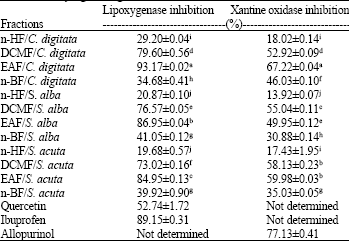Research Article
In vitro Antioxidant, Lipoxygenase and Xanthine Oxidase Inhibitory Activities of Fractions from Cienfuegosia digitata Cav., Sida alba L. and Sida acuta Burn f. (Malvaceae)
Laboratoire de Biochimie et Chimie Appliquees (LABIOCA), UFR/SVT, Universite de Ouagadougou, 09 BP 848 Ouagadougou 09, Burkina Faso
A. Souza
Institut de Pharmacopee et de Medecine Traditionnelle (IPHAMETRA), Centre National de la Recherche Scientifique et Technologique (CENAREST), Libreville-Gabon BP: 1156
A.Y. Coulibaly
Laboratoire de Biochimie et Chimie Appliquees (LABIOCA), UFR/SVT, Universite de Ouagadougou, 09 BP 848 Ouagadougou 09, Burkina Faso
N.T.R. Meda
Laboratoire de Biochimie et Chimie Appliquees (LABIOCA), UFR/SVT, Universite de Ouagadougou, 09 BP 848 Ouagadougou 09, Burkina Faso
M. Kiendrebeogo
Laboratoire de Biochimie et Chimie Appliquees (LABIOCA), UFR/SVT, Universite de Ouagadougou, 09 BP 848 Ouagadougou 09, Burkina Faso
A. Lamien-Meda
Institut for Applied Botany and Pharmacognosy, University of Veterinary Medicine Vienna, Veterinarplatz 1, A-1210 Vienna, Austria
J. Millogo-Rasolodimby
Laboratoire de Biologie et d`Ecologie Vegetales, UFR/SVT, Universite de Ouagadougou, 09 BP 848 Ouagadougou 09, Burkina Faso
M. Lamidi
Institut de Pharmacopee et de Medecine Traditionnelle (IPHAMETRA), Centre National de la Recherche Scientifique et Technologique (CENAREST), Libreville-Gabon BP: 1156
O.G. Nacoulma
Laboratoire de Biochimie et Chimie Appliquees (LABIOCA), UFR/SVT, Universite de Ouagadougou, 09 BP 848 Ouagadougou 09, Burkina Faso











